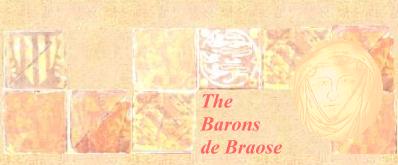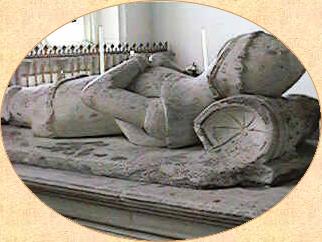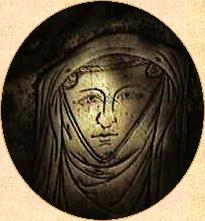
Ward
of Court
John de Braose, lord of Bramber,
Gower and Tetbury fell from his horse at Bramber in 1232. The
Brut y Tywysogyon says he "was drawn at his own horse's
tail; and so he met a cruel death". But the barons
de Braose had not disappeared from history. John had a
son to succeed him.
 John's
heir, William, was only twelve. In spite of his Welsh mother's
efforts to keep her children, she was overruled. Royal
favourites valued the granting of aristocratic wardships because
it placed additional domains within their power, albeit temporarily.
William became a ward of Henry III's chief minister, Peter de
Rivaux. But within two years a warrent was out for Peter's arrest
and his fall was imminent.
John's
heir, William, was only twelve. In spite of his Welsh mother's
efforts to keep her children, she was overruled. Royal
favourites valued the granting of aristocratic wardships because
it placed additional domains within their power, albeit temporarily.
William became a ward of Henry III's chief minister, Peter de
Rivaux. But within two years a warrent was out for Peter's arrest
and his fall was imminent.
The king demanded the return
of Peter's ward and the surrender of the de Braose lands.
Peter de Rivaux flatly refused and sent a message to say that
William de Braose was too ill at present. The king's messenger
reported, however, that "he had found the youth sound and
well, riding a large black Spanish horse, with Peter, from the
town of Rosse towards London."
 William
was finally placed in the wardship of the king's brother, Richard
of Cornwall. He was raised at Henry's court and was probably
introduced to his first wife there. She was another royal
ward and heiress, Alina de Moulton. When he came of age,
the young lord met with a barrage of law suits from the women
of the family, including his mother and sister. Later the children
and relatives of his three wives added further claims for a portion
of the de Braose inheritance.
William
was finally placed in the wardship of the king's brother, Richard
of Cornwall. He was raised at Henry's court and was probably
introduced to his first wife there. She was another royal
ward and heiress, Alina de Moulton. When he came of age,
the young lord met with a barrage of law suits from the women
of the family, including his mother and sister. Later the children
and relatives of his three wives added further claims for a portion
of the de Braose inheritance.
William was removed from
the turmoil of his family's earlier history and became a committed
royalist. His Welsh roots were forgotten and even relations
with his mother appear to have deteriorated. She married
Walter de Clifford and the couple issued several claims against
William arising from her first marriage. William was called
to answer charges that he seized his mother's goods as they were
transported towards Chichester and imprisoned her men.
William
went to some lengths to make provision for all his children and
involved the Countess of Devon in the legal processes.
Decendants of his son Peter lived at Chesworth in Horsham, Sussex and others became the de Braoses of Wiston,
near Steyning. William also negotiated some excellent marriages.
The earliest full length brass memorial of a woman represents
William's daughter Margaret, who married Ralph de Camoys. It
is set in the floor of Trotton church, near Midhurst in Sussex.

back to text

back
to text
 Ward of Court |
||||
The king demanded the return of Peter's ward and the surrender of the de Braose lands. Peter de Rivaux flatly refused and sent a message to say that William de Braose was too ill at present. The king's messenger reported, however, that "he had found the youth sound and well, riding a large black Spanish horse, with Peter, from the town of Rosse towards London."
William was removed from the turmoil of his family's earlier history and became a committed royalist. His Welsh roots were forgotten and even relations with his mother appear to have deteriorated. She married Walter de Clifford and the couple issued several claims against William arising from her first marriage. William was called to answer charges that he seized his mother's goods as they were transported towards Chichester and imprisoned her men. William
went to some lengths to make provision for all his children and
involved the Countess of Devon in the legal processes.
Decendants of his son Peter lived at Chesworth in Horsham, Sussex and others became the de Braoses of Wiston,
near Steyning. William also negotiated some excellent marriages.
The earliest full length brass memorial of a woman represents
William's daughter Margaret, who married Ralph de Camoys. It
is set in the floor of Trotton church, near Midhurst in Sussex.
|
||||